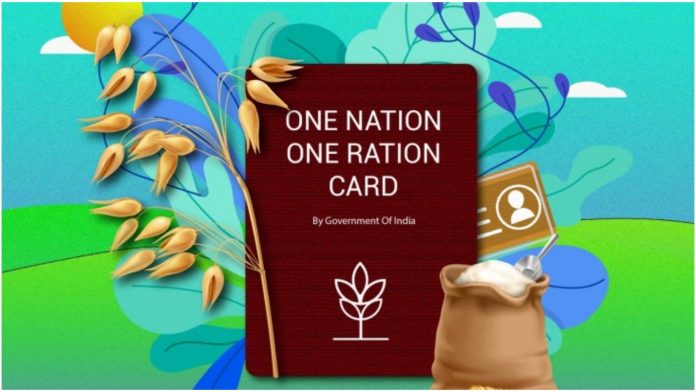This article is written by Aastha Verma, from Kalinga University Raipur, Chhattisgarh. The article emphasized the One Nation, One Ration Card (ONORC) scheme and challenges faced by the migrant workers during the COVID-19 pandemic.
Table of Contents
Introduction
One Nation, One Ration Card (ONORC) Scheme was launched in August 2019. The scheme of one nation, one ration card was designed to make sure that all ration beneficiaries under the National Food Security Act, 2013 can get ration from anywhere throughout the country. They have the right to choose from any Public Distribution System (PDS). The idea was to reform the PDS and it was initially launched as an inter-state pilot.
However, when the COVID-19 pandemic hit India, by 2020 thousand of migrant workers returned to their villages and faced various problems. As a part of economic package relief, the government announced the national rollout of the ONORC Scheme in all states and Union Territories by March 2021. Migrant beneficiaries who are having proper ration cards and have been identified under National Food Security Act, 2013 will get ration in their parent state as well under this plan. The Supreme Court directed all the state and Union Territories to implement one nation, one ration card scheme by 31st July 2021. Also, directed the centre to undertake exercise under Section 9 of the National Food Security Act, 2013 to re-determine the number of persons to be covered under rural and urban areas of states.
By introducing ONORC the idea was to reform the PDS which has been historically being inefficient and has loopholes. Let’s discuss the scheme in detail.
One Nation, One Ration Card Scheme (ONORC)
The Scheme of ONORC applies to those citizens who are in Below Poverty Line (BPL) category. The beneficiaries are identified based on AADHAR identification through the electronic device known as Point of Sale (PoS). This device is available in all the Public Distribution System shops. The system identifies beneficiaries through biometric authentication on a PoS device at the fair shop. The system runs through the two portals – Integrated Management of Public Distribution System (IM-PDS) and Annavitran which host all relevant data. The beneficiary should match the real-time data with the details on the Annavitran portal. The main object of this scheme is to improve the country’s Hunger Index and to reduce the influence and role of middlemen.
This scheme also ensures that people have access to food grain even if they shift from their native place to another place of work. The scheme is beneficial to migrant workers and labourers, daily workers, beggars, etc., as they move from one place to another in search of work. It ensures the interstate portability of the ration card. The progress of the implementation of the plan is reviewed by the Union Minister of Consumer Affairs, Public Distribution.
As per the scheme, the 17 states that have implemented the ONORC reform, were allowed to borrow an additional Rs.37,600 crore in 2021. Under the National Food Security Act, 2013, about 81 crore people are entitled to the subsidy of food grain rice at Rs 3/kg, wheat at Rs. 2/kg and grain at Re.1/kg from the fair shops. Also, according to the National Food Security Act, households covered under the Antyodya Anna Yojana (AAY) are entitled to receive 35kg of food grains per household.
The ration cardholder is assigned a fair shop in the locality where his ration card is registered. Till now 33 states and Union Territories have joined the ONORC scheme, covering about 69 crore National Food Security Act beneficiaries. Delhi is the latest union territory to enable the ONORC scheme. Three states are yet to join this scheme, they are Chhatisgrah, Assam, West Bengal. West Bengal will complete the installation of the necessary infrastructure to roll out the platform. Chhattisgarh will start the ONORC scheme when there is sufficient purchase of a PoS machine. Assam is trying its best to implement the scheme and has collected all the relevant information of AADHAR of the beneficiaries.
Inter-state migration
With growing inter-state migration from village to urban areas the government’s effort was to ensure that migrant workers and their families have nutritious food and can avail the benefit of the National Food Security Act, 2013. From this policy, migrant workers can take foodgrains from anywhere throughout the territory of India. The ration shops and food distribution shops play a key role in helping the migrant to live at their place of work, as it helps the workers to get their necessities at a subsidized rate.
Right to food
The fundamental right to life is defined under Article 21 of the Indian Constitution which includes the right to live with human dignity, having the right to food, and other necessities.
Benefits of scheme
- Under the scheme, beneficiaries from one state can get their share of the ration in other states as well, no matter from which state they belong.
- It will give them the opportunity to choose the dealer of their choice.
- It will be beneficial for women and other vulnerable groups given the social identity based on caste, class or gender provides a strong backdrop in accessing the Public Distribution System.
- This scheme will help in achieving the target set under Sustainable Development Goals (SDG). It will also help to identify the poor state of hunger in India as highlighted in the Global Hunger Index.
- The government has provided incentives to the state and set a pre-condition for additional borrowing by states during the COVID-19 pandemic.
Supreme Court judgment
In the case of Re Problems and miseries of migrant workers, the Supreme Court takes the suo moto cognizance of the case. After Maharashtra and Gujarat had implemented the scheme successfully, the Supreme Court ordered that it was to be implemented by other states too. The bench emphasized that no excuses were to be given regarding the implementation of the scheme. The issue of the non-availability of resources to unregistered migrants was highlighted by Senior Advocate Dushyant Dave. He said that there is not sufficient data to check the vulnerable sections of society.
The Solicitor General responded to this and said that the Pradhan Mantri Gareeb Kalyan Yojana has been extended up to November. The Additional Solicitor General stated that 8 lakh metric tonnes of food grain are given to the centre for the redistribution of grain to all states. The court raised concern over the migrant workers who do not possess any form of identification could avail the benefit of the scheme. The court also inquired about the progress of the scheme and the setting up of a database that they receive the due benefits. The Union Secretary informed us that the portal is ready. Every state is complaining about the lack of access to the portal.
Those who were registered under the Code of Social Security were to be incorporated into the registration. The court emphasized the need for a Common National Database for all unorganized workers. Also, directed the Ministry of Labour and Employment to create the database with the collaboration of state governments. The central and the state governments should complete the registration process of organized workers so that unorganized workers can also access the benefit of the scheme which is initiated by the Indian government. The Supreme Court also directed the state government to introduce a scheme to supply dry food grains and set up a community kitchen to ensure that migrant workers do not go hungry during the COVID-19 pandemic.
The scheme reduces worries of the poor – PMGKY
Pradhan Mantri Gareeb Kalyan Anna Yojana is a food security welfare scheme that was envisaged by the Prime Minister to provide assistance and help mitigate the economic impact of COVID-19. Prime Minister Narendra Modi addressed the beneficiaries of Pradhan Mantri Gareeb Kalyan Anna Yojana and said that this scheme has reduced the worries of the poor and increased their confidence. The free ration is being distributed to numerous families in Gujarat which has reduced the worries of the poor in the pandemic. Further, added that the country is spending lakhs of crore on infrastructure just to improve the quality of life of human beings, it is targeting the new benchmarks for ease of living and keeping the empowerment of the poor in top priority.
Food security and COVID-19 pandemic
During the COVID-19 crisis, millions of migrant workers faced the problem of food security. This forced them to travel during the pandemic which increases the spread of the virus and risks to their health. Some of the migrant workers walked hundreds of miles as they had minimal savings and were limited to access the benefit. Thus, food security became a critical concern. India set up PDS in 1944 to deliver subsidized food to citizens. Using ration cards, people may purchase the food grains from fair shops at subsidized rates. About 230 million cardholders and 534,000 shops and 88% of which possess electronic PoS machines. During lockdowns, ration cardholders are allowed to purchase food at cheaper rates or free food distribution from the government. As the lockdown started in India, Finance Minister Nirmala Sitharaman announced a free supply of food grains and cash payments to women and poor citizens under the Pradhan Mantri Gareeb Kalyan Yojana. The Food Secretary also said that the center was providing grains to states through the Open Market Sale Scheme (OMSS) to allow them to provide additional support to their citizens of the state. The center has given the responsibility to provide food grains to persons who do not possess any state card, even knowing that there is an additional financial burden on the state during the crisis.
Despite many measures taken by the government many citizens, especially migrant workers were left without access to these benefits. PDS has been unable to account for a mobile migrant population and people are struggling with the issuance of ration cards and AADHAR cards which has affected the economy severely.
During the COVID-19 pandemic, the policymakers are faced with the dual objective of ensuring that citizens should follow the COVID-19 protocols and on the other side all have access to food. A major concern of food security is with the migrant workers as they have a lack of access to take subsidies from PDS. As before the amended scheme the cardholders cannot take the subsidy in any other state. Intra-state probability was available with the 12 states at the start which allow the migrant workers to procure food at their place of work.
Conclusion
The scheme of the One Nation One Ration Card (ONORC) is implemented in order to distribute the ration free of cost from the Public Distribution System (PDS) cardholders. The beneficiaries of biometric authentication will get free rations from fair-price shops. This plan is to make food security portable.
COVID-19 not only represents a health crisis but also there is a scarcity of foodgrains and migrant workers are dying because of starvation. Public policies that provide food grains have the potential to help the migrant workers to restrict their movement, but policy implementation needs time, which may lead to being less effective when implemented across borders. Food distribution activists by local government stakeholders need to tide migrant workers over through this pandemic. Activists pointed out that the usage under the scheme has been low especially in states where they do not have electronic point-of-sale machines which need to implement the scheme. In wake of this situation and to prevent it from repeating in the future, the central, as well as state government, should initiate the welfare scheme for the unorganized society and should welcome the court’s order as it will direct the government to take a significant step towards the development of the country.
References
- https://www.google.com/url?sa=t&source=web&rct=j&url=https://www.hbs.edu/faculty/Publication%2520Files/20-113_161beda2-929b-417a-80fa-3844506b7c19.pdf&ved=2ahUKEwiFr_ejw5TyAhXimuYKHQH0DDAQFjAFegQIDBAC&usg=AOvVaw2DYp8WjTrKU9lkqCUuMSf3
- https://www.thehindu.com/news/national/people-without-ration-cards-left-out-of-covid-19-food-safety-net/article34402738.ece
- https://www.zeebiz.com/india/news-big-decision-one-nation-one-ration-card-scheme-to-be-implemented-in-delhi-beneficiaries-have-to-complete-this-process-to-get-free-ration-from-fair-price-shops-161074
- https://www.hbs.edu/ris/Publication%20Files/20-113_161beda2-929b-417a-80fa-3844506b7c19.pdf
- https://www.nic.in/infographs_post/one-nation-one-ration-card/
LawSikho has created a telegram group for exchanging legal knowledge, referrals, and various opportunities. You can click on this link and join:
 Serato DJ Crack 2025Serato DJ PRO Crack
Serato DJ Crack 2025Serato DJ PRO Crack











 Allow notifications
Allow notifications



